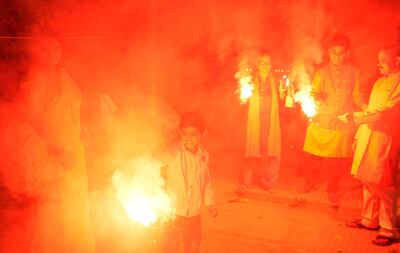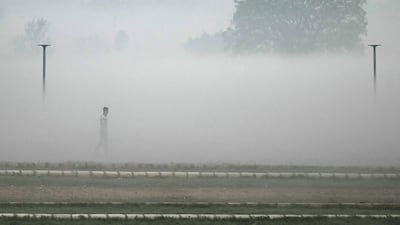Residents in the Indian capital Delhi woke to a thick blanket of smog as air pollution reached dangerous levels after fireworks and other pyrotechnic displays set off to mark Diwali, despite a court ban.
Average air quality levels in the city were recorded at more than 400 on the Air Quality Index, or AQI, on Monday, according to the Central Pollution Control Board, India’s leading environmental watchdog, after fireworks throughout Sunday and the early hours of Monday morning.
A similar air quality situation was seen in Noida, Ghaziabad, Gurgaon and Faridabad.
Kolkata, the capital of West Bengal state, was also cloaked in haze as air quality levels were recorded at poor levels, a lingering effect from Diwali celebrations.
The Air Quality Index measures the quality of air and the amount of dust and other particles in the atmosphere. Calculations are based on a host of pollutants including levels of nitrogen dioxide and carbon monoxide.
In some places, the AQI reached 900 or above. A reading between zero and 50 is considered good, 51-100 is satisfactory and 101-200 moderate. However, 201-300 is considered poor, 301-400 very poor and 401-500 severe.
At Delhi's Jawaharlal Nehru Stadium, AQI was recorded at 910, while in Lajpat Nagar the AQI was 959, according to AQI India, a real-time pollution monitoring platform.
The city’s pollution levels rose after a slight improvement throughout the weekend due to rain on Saturday making it the best Diwali air quality in eight years, with fireworks and pyrotechnics thought to be a significant factor.
The sale of fireworks is banned by the Supreme Court, but residents flouted the ban, despite warnings by authorities that such actions could affect air quality levels.
Toxic emissions from the displays, along with smoke from farm fires engulfed the city on Monday morning, with visibility significantly dropping.
Delhi has experienced high levels of toxic air since October.
Authorities have implemented desperate measures to try to bring air pollution levels down. Schools have been government offices have been closed, water sprinklers have been installed and construction and heavy vehicles have, at times, been banned. An odd-even traffic restriction plan that would allow vehicles with odd and even number plates to travel on alternate days to curb pollution was also considered.
The plan has been shelved, however.
Following Diwali celebrations, many residents have complained about congestion, headaches, burning eyes and itchy throats as a result of the air quality.
“I am unable to breathe. My nose and eyes are burning. It is a difficult situation,” Chayanika Nigam, a Noida resident, told The National.
Key figures in the life of the fort
Sheikh Dhiyab bin Isa (ruled 1761-1793) Built Qasr Al Hosn as a watchtower to guard over the only freshwater well on Abu Dhabi island.
Sheikh Shakhbut bin Dhiyab (ruled 1793-1816) Expanded the tower into a small fort and transferred his ruling place of residence from Liwa Oasis to the fort on the island.
Sheikh Tahnoon bin Shakhbut (ruled 1818-1833) Expanded Qasr Al Hosn further as Abu Dhabi grew from a small village of palm huts to a town of more than 5,000 inhabitants.
Sheikh Khalifa bin Shakhbut (ruled 1833-1845) Repaired and fortified the fort.
Sheikh Saeed bin Tahnoon (ruled 1845-1855) Turned Qasr Al Hosn into a strong two-storied structure.
Sheikh Zayed bin Khalifa (ruled 1855-1909) Expanded Qasr Al Hosn further to reflect the emirate's increasing prominence.
Sheikh Shakhbut bin Sultan (ruled 1928-1966) Renovated and enlarged Qasr Al Hosn, adding a decorative arch and two new villas.
Sheikh Zayed bin Sultan (ruled 1966-2004) Moved the royal residence to Al Manhal palace and kept his diwan at Qasr Al Hosn.
Sources: Jayanti Maitra, www.adach.ae
The biog
Name: James Mullan
Nationality: Irish
Family: Wife, Pom; and daughters Kate, 18, and Ciara, 13, who attend Jumeirah English Speaking School (JESS)
Favourite book or author: “That’s a really difficult question. I’m a big fan of Donna Tartt, The Secret History. I’d recommend that, go and have a read of that.”
Dream: “It would be to continue to have fun and to work with really interesting people, which I have been very fortunate to do for a lot of my life. I just enjoy working with very smart, fun people.”
A little about CVRL
Founded in 1985 by Sheikh Mohammed bin Rashid, Vice President and Ruler of Dubai, the Central Veterinary Research Laboratory (CVRL) is a government diagnostic centre that provides testing and research facilities to the UAE and neighbouring countries.
One of its main goals is to provide permanent treatment solutions for veterinary related diseases.
The taxidermy centre was established 12 years ago and is headed by Dr Ulrich Wernery.
The specs: 2018 BMW R nineT Scrambler
Price, base / as tested Dh57,000
Engine 1,170cc air/oil-cooled flat twin four-stroke engine
Transmission Six-speed gearbox
Power 110hp) @ 7,750rpm
Torque 116Nm @ 6,000rpm
Fuel economy, combined 5.3L / 100km
Ten tax points to be aware of in 2026
1. Domestic VAT refund amendments: request your refund within five years
If a business does not apply for the refund on time, they lose their credit.
2. E-invoicing in the UAE
Businesses should continue preparing for the implementation of e-invoicing in the UAE, with 2026 a preparation and transition period ahead of phased mandatory adoption.
3. More tax audits
Tax authorities are increasingly using data already available across multiple filings to identify audit risks.
4. More beneficial VAT and excise tax penalty regime
Tax disputes are expected to become more frequent and more structured, with clearer administrative objection and appeal processes. The UAE has adopted a new penalty regime for VAT and excise disputes, which now mirrors the penalty regime for corporate tax.
5. Greater emphasis on statutory audit
There is a greater need for the accuracy of financial statements. The International Financial Reporting Standards standards need to be strictly adhered to and, as a result, the quality of the audits will need to increase.
6. Further transfer pricing enforcement
Transfer pricing enforcement, which refers to the practice of establishing prices for internal transactions between related entities, is expected to broaden in scope. The UAE will shortly open the possibility to negotiate advance pricing agreements, or essentially rulings for transfer pricing purposes.
7. Limited time periods for audits
Recent amendments also introduce a default five-year limitation period for tax audits and assessments, subject to specific statutory exceptions. While the standard audit and assessment period is five years, this may be extended to up to 15 years in cases involving fraud or tax evasion.
8. Pillar 2 implementation
Many multinational groups will begin to feel the practical effect of the Domestic Minimum Top-Up Tax (DMTT), the UAE's implementation of the OECD’s global minimum tax under Pillar 2. While the rules apply for financial years starting on or after January 1, 2025, it is 2026 that marks the transition to an operational phase.
9. Reduced compliance obligations for imported goods and services
Businesses that apply the reverse-charge mechanism for VAT purposes in the UAE may benefit from reduced compliance obligations.
10. Substance and CbC reporting focus
Tax authorities are expected to continue strengthening the enforcement of economic substance and Country-by-Country (CbC) reporting frameworks. In the UAE, these regimes are increasingly being used as risk-assessment tools, providing tax authorities with a comprehensive view of multinational groups’ global footprints and enabling them to assess whether profits are aligned with real economic activity.
Contributed by Thomas Vanhee and Hend Rashwan, Aurifer
Apple product price list
iPad Pro
11" - $799 (64GB)
12.9" - $999 (64GB)
MacBook Air
$1,199
Mac Mini
$799
MATCH INFO
Fulham 0
Aston Villa 3 (Grealish 4', Hourihane 15', Mings 48')
Man of the match: Jack Grealish (Aston Villa)
India team for Sri Lanka series
Test squad: Rohit Sharma (captain), Priyank Panchal, Mayank Agarwal, Virat Kohli, Shreyas Iyer, Hanuma Vihari, Shubhman Gill, Rishabh Pant (wk), KS Bharath (wk), Ravindra Jadeja, Jayant Yadav, Ravichandran Ashwin, Kuldeep Yadav, Sourabh Kumar, Mohammed Siraj, Umesh Yadav, Mohammed Shami, Jasprit Bumrah.
T20 squad: Rohit Sharma (captain), Ruturaj Gaikwad, Shreyas Iyer, Surya Kumar Yadav, Sanju Samson, Ishan Kishan (wk), Venkatesh Iyer, Deepak Chahar, Deepak Hooda, Ravindra Jadeja, Yuzvendra Chahal, Ravi Bishnoi, Kuldeep Yadav, Mohammed Siraj, Bhuvneshwar Kumar, Harshal Patel, Jasprit Bumrah, Avesh Khan
Despacito's dominance in numbers
Released: 2017
Peak chart position: No.1 in more than 47 countries, including the United States, the United Kingdom, Australia and Lebanon
Views: 5.3 billion on YouTube
Sales: With 10 million downloads in the US, Despacito became the first Latin single to receive Diamond sales certification
Streams: 1.3 billion combined audio and video by the end of 2017, making it the biggest digital hit of the year.
Awards: 17, including Record of the Year at last year’s prestigious Latin Grammy Awards, as well as five Billboard Music Awards
The biog
Marital status: Separated with two young daughters
Education: Master's degree from American Univeristy of Cairo
Favourite book: That Is How They Defeat Despair by Salwa Aladian
Favourite Motto: Their happiness is your happiness
Goal: For Nefsy to become his legacy long after he is gon
Paatal Lok season two
Directors: Avinash Arun, Prosit Roy
Stars: Jaideep Ahlawat, Ishwak Singh, Lc Sekhose, Merenla Imsong
Rating: 4.5/5
How to avoid crypto fraud
- Use unique usernames and passwords while enabling multi-factor authentication.
- Use an offline private key, a physical device that requires manual activation, whenever you access your wallet.
- Avoid suspicious social media ads promoting fraudulent schemes.
- Only invest in crypto projects that you fully understand.
- Critically assess whether a project’s promises or returns seem too good to be true.
- Only use reputable platforms that have a track record of strong regulatory compliance.
- Store funds in hardware wallets as opposed to online exchanges.
The five pillars of Islam
1. Fasting
2. Prayer
3. Hajj
4. Shahada
5. Zakat
GIANT REVIEW
Starring: Amir El-Masry, Pierce Brosnan
Director: Athale
Rating: 4/5
Benefits of first-time home buyers' scheme
- Priority access to new homes from participating developers
- Discounts on sales price of off-plan units
- Flexible payment plans from developers
- Mortgages with better interest rates, faster approval times and reduced fees
- DLD registration fee can be paid through banks or credit cards at zero interest rates
MOUNTAINHEAD REVIEW
Starring: Ramy Youssef, Steve Carell, Jason Schwartzman
Director: Jesse Armstrong
Rating: 3.5/5
The%20Afghan%20connection
%3Cp%3EThe%20influx%20of%20talented%20young%20Afghan%20players%20to%20UAE%20cricket%20could%20have%20a%20big%20impact%20on%20the%20fortunes%20of%20both%20countries.%20Here%20are%20three%20Emirates-based%20players%20to%20watch%20out%20for.%0D%3Cbr%3E%20%0D%3Cbr%3E%3Cstrong%3EHassan%20Khan%20Eisakhil%3C%2Fstrong%3E%0D%3Cbr%3EMohammed%20Nabi%20is%20still%20proving%20his%20worth%20at%20the%20top%20level%20but%20there%20is%20another%20reason%20he%20is%20raging%20against%20the%20idea%20of%20retirement.%20If%20the%20allrounder%20hangs%20on%20a%20little%20bit%20longer%2C%20he%20might%20be%20able%20to%20play%20in%20the%20same%20team%20as%20his%20son%2C%20Hassan%20Khan.%20The%20family%20live%20in%20Ajman%20and%20train%20in%20Sharjah.%0D%3Cbr%3E%20%0D%3Cbr%3E%3Cstrong%3EMasood%20Gurbaz%3C%2Fstrong%3E%0D%3Cbr%3EThe%20opening%20batter%2C%20who%20trains%20at%20Sharjah%20Cricket%20Academy%2C%20is%20another%20player%20who%20is%20a%20part%20of%20a%20famous%20family.%20His%20brother%2C%20Rahmanullah%2C%20was%20an%20IPL%20winner%20with%20Kolkata%20Knight%20Riders%2C%20and%20opens%20the%20batting%20with%20distinction%20for%20Afghanistan.%0D%3Cbr%3E%20%0D%3Cbr%3E%3Cstrong%3EOmid%20Rahman%3C%2Fstrong%3E%0D%3Cbr%3EThe%20fast%20bowler%20became%20a%20pioneer%20earlier%20this%20year%20when%20he%20became%20the%20first%20Afghan%20to%20represent%20the%20UAE.%20He%20showed%20great%20promise%20in%20doing%20so%2C%20too%2C%20playing%20a%20key%20role%20in%20the%20senior%20team%E2%80%99s%20qualification%20for%20the%20Asia%20Cup%20in%20Muscat%20recently.%0D%3Cbr%3E%3C%2Fp%3E%0A
Company%20profile
%3Cp%3E%3Cstrong%3EName%3A%3C%2Fstrong%3E%20WallyGPT%3Cbr%3E%3Cstrong%3EStarted%3A%20%3C%2Fstrong%3E2014%3Cbr%3E%3Cstrong%3EFounders%3A%20%3C%2Fstrong%3ESaeid%20and%20Sami%20Hejazi%3Cbr%3E%3Cstrong%3EBased%3A%3C%2Fstrong%3E%20Dubai%3Cbr%3E%3Cstrong%3ESector%3A%20%3C%2Fstrong%3EFinTech%3Cbr%3E%3Cstrong%3EInvestment%20raised%3A%20%3C%2Fstrong%3E%247.1%20million%3Cbr%3E%3Cstrong%3ENumber%20of%20staff%3A%3C%2Fstrong%3E%2020%3Cbr%3E%3Cstrong%3EInvestment%20stage%3A%20%3C%2Fstrong%3EPre-seed%20round%3C%2Fp%3E%0A
THE SPECS
Engine: 1.5-litre
Transmission: 6-speed automatic
Power: 110 horsepower
Torque: 147Nm
Price: From Dh59,700
On sale: now
Zodi%20%26%20Tehu%3A%20Princes%20Of%20The%20Desert
%3Cp%3E%3Cstrong%3EDirector%3A%20%3C%2Fstrong%3EEric%20Barbier%26nbsp%3B%3C%2Fp%3E%0A%3Cp%3E%3Cstrong%3EStarring%3A%20%3C%2Fstrong%3EYoussef%20Hajdi%2C%20Nadia%20Benzakour%2C%20Yasser%20Drief%3C%2Fp%3E%0A%3Cp%3E%3Cstrong%3ERating%3A%3C%2Fstrong%3E%204%2F5%3C%2Fp%3E%0A



